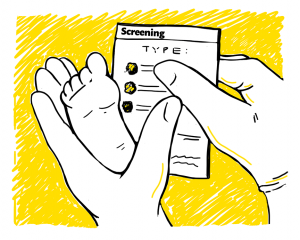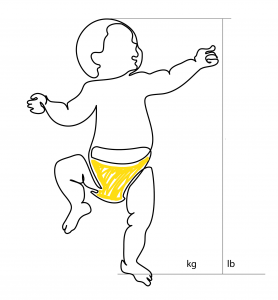An Everyday DNA blog article
Written by: Sarah Sharman, PhD, Science writer
Illustrated by: Cathleen Shaw
Every baby born at a hospital in the United States receives newborn screening to look for serious-but-treatable conditions that occur during childhood. Universal newborn screening is one of the most successful public health efforts in the U.S. in the 20th century. Of the four million newborns screened in the U.S. annually, one out of every 300 will test positive for one of the conditions covered with a newborn screen.
Another tool called genome sequencing is being used to help diagnose critically ill babies whose symptoms have stumped their doctors. Genome sequencing analyzes a baby’s entire DNA code, or genome, to look for changes in the DNA that might contribute to disease. It has been successful at providing diagnoses for babies with rare, undiagnosed diseases.
So, the question arises: should the genome of every baby, even healthy ones, be sequenced at birth? Currently, it is a hot topic with the United Kingdom launching a program to do just that. Let’s learn about the current screening protocols in the U.S. and how genomics is playing a role in them.
Current newborn screening methods
Newborn screening began in the early 1960s with the development of a screening test for the metabolic disorder phenylketonuria (PKU). PKU is a serious metabolic disorder characterized by the body’s inability to metabolize the amino acid phenylalanine. If left untreated, phenylalanine can build up in the blood and damage the nervous system and brain, which can lead to permanent intellectual disability, seizures, and deafness. Babies with PKU can lead a healthy life by following a low-phenylalanine diet to avoid symptoms of the disease.
 Today, newborn screening programs have been expanded to include more than 35 core conditions formally recommended by the Health Resources Services Administration (HRSA). Current conditions that are part of newborn screening tests in the U.S. include several metabolic disorders, endocrine disorders, hemoglobin disorders (including sickle cell), and other disorders like critical congenital heart disease, cystic fibrosis, hearing loss, severe combined immunodeficiencies (SCID), and spinal muscular atrophy.
Today, newborn screening programs have been expanded to include more than 35 core conditions formally recommended by the Health Resources Services Administration (HRSA). Current conditions that are part of newborn screening tests in the U.S. include several metabolic disorders, endocrine disorders, hemoglobin disorders (including sickle cell), and other disorders like critical congenital heart disease, cystic fibrosis, hearing loss, severe combined immunodeficiencies (SCID), and spinal muscular atrophy.
Newborn screening consists of several tests to assess an infant’s heart health, hearing, and the presence of molecules or proteins in the blood that are indicative of potential disease. Pulse oximetry is a non-invasive test used to measure the amount of oxygen in the baby’s blood, an indication of heart and lung function. Babies also have a small blood sample collected through a little prick to their heel, called a heel stick. The blood sample is used for metabolic and genetic analysis. If the newborn screen identifies a potential condition, the baby receives definitive follow-up testing to determine if the condition is truly present. 
Each state in the U.S. runs its own newborn screening program. Almost all of the states screen newborns for at least 30, often more than 50, treatable diseases. When deciding which conditions to look for in newborns, states focus on conditions that are serious or life threatening, can be effectively treated, and can be reliably and affordably detected.
How can genome sequencing play a role in newborn screening?
Genetic testing is often used to confirm a positive result on the newborn screen. In this case, one or two genes related to the condition are sequenced. Whole genome sequencing, on the other hand, identifies all of the three billion base pairs in a person’s genetic code. The genome sequence is then compared to a reference genome to generate a list of differences, known as gene variants.
Currently, genome sequencing is being adopted in neonatal intensive care units to help diagnose babies whose conditions have escaped diagnosis using traditional newborn screening. Researchers at the HudsonAlpha Institute for Biotechnology were part of a clinical research study called SouthSeq that provides free genome sequencing to a large and diverse set of families with babies who have symptoms suggestive of a genetic disorder. Through the study, about 30 percent of babies have received a diagnosis using genome sequencing.
The success of genome sequencing for children with rare and undiagnosed disease has led some people to ask, Should genome sequencing become a routine part of newborn screens for all babies? The United Kingdom thinks the answer is, yes. They have begun a pilot study in which up to 200,000 babies’ genomes will be sequenced and analyzed.
Proponents of universal newborn genome sequencing argue that genome sequencing can speed up diagnoses for diseases that a child may develop later in life. Genome sequencing could also identify actionable childhood and early adulthood genetic conditions for which there are existing treatments and interventions.
New conditions could easily be added to the screening list since the entire genome is already being sequenced. The large datasets of genomic data and linked health records could allow scientists to learn more about the role of genetics in health and disease. For these reasons, advocates of universal newborn screening believe that it could help set the stage for predictive, preventative, personalized health care in the future.
Others feel caution for including genome sequencing as part of universal newborn screening. Some genetic variants are reliably associated with diseases, disabilities, and other physical and mental traits. However, other variants have weak associations with specific conditions or traits, making it difficult to determine when, if, and how a child might be impacted. Screening for genes that are less well understood creates the risk for false positives and unnecessary worry for families.
In a more practical argument, genome sequencing could not replace the heel prick test in newborn screening because genome sequencing can be less reliable at picking up certain metabolic disorders. Some conditions such as spinal muscular atrophy may be detected more readily using a targeted gene test, optimized to pick up certain mutations.
From an ethical standpoint, universal newborn genome sequencing takes away a child’s ability to choose to have their genome sequenced. And if a genetic predisposition is found in a baby, will this go in their medical records? If so, what will this mean for future health insurance?
While there are still many questions that remain to be answered before genome sequencing becomes a mainstay in universal newborn screening, it is easy to see that genetics and genomics have already helped in the diagnosis of rare diseases in many babies.




